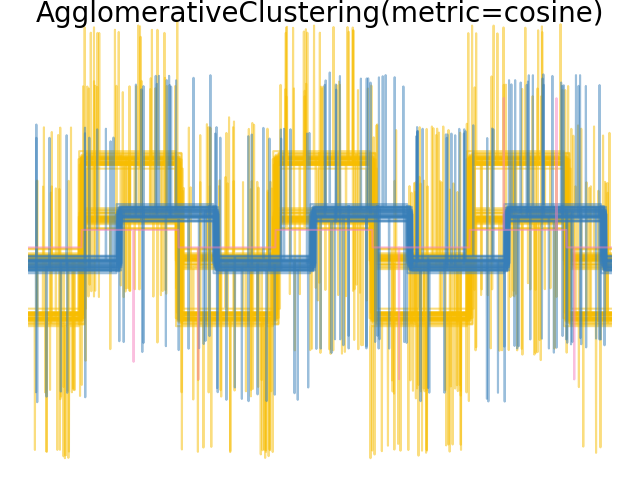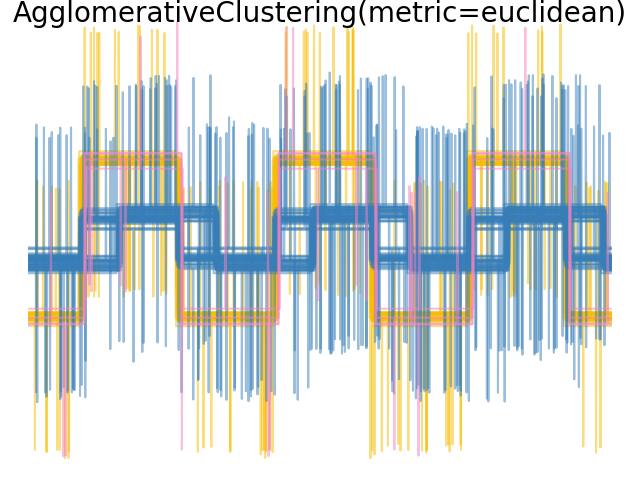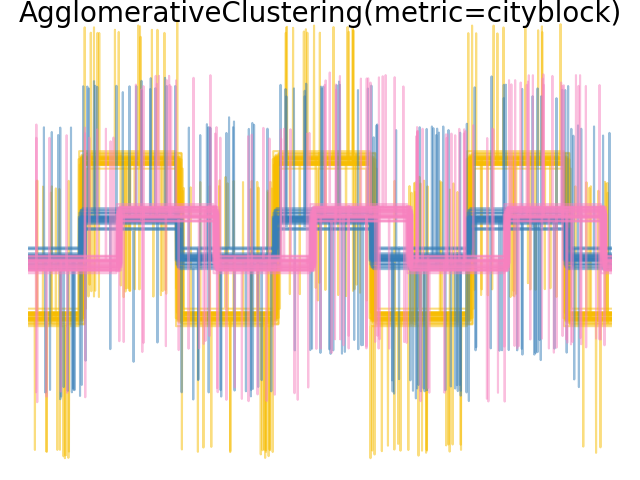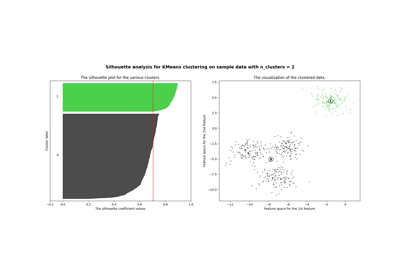Note
Go to the end to download the full example code. or to run this example in your browser via Binder
使用不同度量的凝聚聚类#
演示不同度量对层次聚类的影响。
该示例旨在展示选择不同度量的效果。它应用于波形,可以看作是高维向量。实际上,度量之间的差异在高维中通常更为明显(特别是对于欧几里得和城市街区距离)。
我们从三组波形中生成数据。两个波形(波形1和波形2)是成比例的。余弦距离对数据的缩放是不变的,因此它无法区分这两个波形。因此,即使没有噪声,使用这种距离进行聚类也不会将波形1和2分开。
我们向这些波形添加观测噪声。我们生成非常稀疏的噪声:只有6%的时间点包含噪声。因此,这种噪声的l1范数(即“城市街区”距离)比其l2范数(“欧几里得”距离)小得多。这可以在类间距离矩阵中看到:对角线上的值,表征类的扩展,对于欧几里得距离来说比城市街区距离大得多。
当我们将聚类应用于数据时,我们发现聚类反映了距离矩阵中的情况。实际上,对于欧几里得距离,由于噪声,类分离不好,因此聚类不会将波形分开。对于城市街区距离,分离效果很好,波形类得以恢复。最后,余弦距离根本无法区分波形1和2,因此聚类将它们放在同一个簇中。
# 作者:scikit-learn 开发者
# SPDX-License-Identifier: BSD-3-Clause
import matplotlib.patheffects as PathEffects
import matplotlib.pyplot as plt
import numpy as np
from sklearn.cluster import AgglomerativeClustering
from sklearn.metrics import pairwise_distances
np.random.seed(0)
# 生成波形数据
n_features = 2000
t = np.pi * np.linspace(0, 1, n_features)
def sqr(x):
return np.sign(np.cos(x))
X = list()
y = list()
for i, (phi, a) in enumerate([(0.5, 0.15), (0.5, 0.6), (0.3, 0.2)]):
for _ in range(30):
phase_noise = 0.01 * np.random.normal()
amplitude_noise = 0.04 * np.random.normal()
additional_noise = 1 - 2 * np.random.rand(n_features)
# 使噪声稀疏
additional_noise[np.abs(additional_noise) < 0.997] = 0
X.append(
12
* (
(a + amplitude_noise) * (sqr(6 * (t + phi + phase_noise)))
+ additional_noise
)
)
y.append(i)
X = np.array(X)
y = np.array(y)
n_clusters = 3
labels = ("Waveform 1", "Waveform 2", "Waveform 3")
colors = ["#f7bd01", "#377eb8", "#f781bf"]
# Plot the ground-truth labelling
plt.figure()
plt.axes([0, 0, 1, 1])
for l, color, n in zip(range(n_clusters), colors, labels):
lines = plt.plot(X[y == l].T, c=color, alpha=0.5)
lines[0].set_label(n)
plt.legend(loc="best")
plt.axis("tight")
plt.axis("off")
plt.suptitle("Ground truth", size=20, y=1)
# 绘制距离图
for index, metric in enumerate(["cosine", "euclidean", "cityblock"]):
avg_dist = np.zeros((n_clusters, n_clusters))
plt.figure(figsize=(5, 4.5))
for i in range(n_clusters):
for j in range(n_clusters):
avg_dist[i, j] = pairwise_distances(
X[y == i], X[y == j], metric=metric
).mean()
avg_dist /= avg_dist.max()
for i in range(n_clusters):
for j in range(n_clusters):
t = plt.text(
i,
j,
"%5.3f" % avg_dist[i, j],
verticalalignment="center",
horizontalalignment="center",
)
t.set_path_effects(
[PathEffects.withStroke(linewidth=5, foreground="w", alpha=0.5)]
)
plt.imshow(avg_dist, interpolation="nearest", cmap="cividis", vmin=0)
plt.xticks(range(n_clusters), labels, rotation=45)
plt.yticks(range(n_clusters), labels)
plt.colorbar()
plt.suptitle("Interclass %s distances" % metric, size=18, y=1)
plt.tight_layout()
# 绘制聚类结果
for index, metric in enumerate(["cosine", "euclidean", "cityblock"]):
model = AgglomerativeClustering(
n_clusters=n_clusters, linkage="average", metric=metric
)
model.fit(X)
plt.figure()
plt.axes([0, 0, 1, 1])
for l, color in zip(np.arange(model.n_clusters), colors):
plt.plot(X[model.labels_ == l].T, c=color, alpha=0.5)
plt.axis("tight")
plt.axis("off")
plt.suptitle("AgglomerativeClustering(metric=%s)" % metric, size=20, y=1)
plt.show()
Total running time of the script: (0 minutes 0.528 seconds)
Related examples












